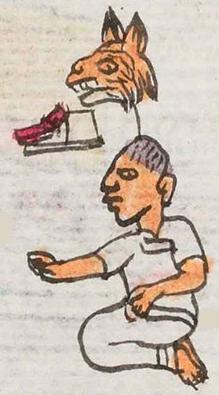Coyocac (Mdz13r)
This compound glyph for the place name Coyocac begins with a coyote (coyotl) head at the top. The coyote faces to the viewer's left. His coat is terracotta colored, but under his chin it is white. His mouth is open, and we can see some teeth. Below the coyote head is a white sandal (cactli) with a red tie. Below that is a seated woman, kneeling as was the custom, wearing a skirt and a huipilli. She also faces to the viewer's left, with one arm reaching out. She has very short gray or purple hair.
Stephanie Wood
The coyote is a phonetic indicator that is meant to provide the reading of "coyoc" [from coyoctli, hole] rather than literally a reference to the anima. The "ā" [from atl), water], and the locative suffix, -c, provide the meaning "By the Watering Hole," although water is not depicted. [See Gordon Whittaker, Deciphering Aztec Hieroglyphs, 2021, 100.]
The sandal phonetically reinforces the "cac" in the place name, but has no semantic contribution. The glyph for this place name in the Matrícula de Huexotzinco provides just the coyote head and the sandal.
Whittaker's interpretation differs from the one by Berdan and Anawalt, who apparently see the woman as representative of an ethnic group, the Coyuca. Wimmer's Nahuatl dictionary, cited in the UNAM's Tlachia also suggests a reading relating to the ethnicity.
The seated woman with a white tunic and skirt, her right arm stretched out before her, and a very short hairdo. Her hair stands out as unusual, being just a stubble, shorn off. Often, when human figures appear in a hieroglyphic place name they can provide a visual reference to the local ethnicity. See the other glyph for Coyocac in the Codex Mendoza (below, right), which is just a person's head with this same hair style.
Stephanie Wood
coyucac. puo
Coyocac, pueblo (Coyuca de Benítez o Coyoquilla, Guerrero?)
Stephanie Wood
c. 1541, or by 1553 at the latest
Stephanie Wood
coyotes, sandals, huaraches, shoes, footwear, women, mujeres, huipiles, mapilhuia, mahpilhuia, señalar con la mano, nombres de lugares

coyo(tl), coyote, https://nahuatl.wired-humanities.org/content/coyotl
cac(tli), sandals or shoes, https://nahuatl.wired-humanities.org/content/cactli
coyoc(tli), hole, https://nahuatl.wired-humanities.org/content/coyoctli
-c (locative suffix), https://nahuatl.wired-humanities.org/content/c
mapilhuia, to point a finger, https://nahuatl.wired-humanities.org/content/mapilhuia
(Karttunen has not provided an independent interpretation for this glyph. See the scholars' interpretations, below.)
"By the Watering Hole" (Whittaker, 2021, 100); "In the Place of the Coyuca" (Berdan and Anawalt, 1992, vol. 1, p. 181)
"Junto al Bebedero" o "Lugar de los Coyuca"
Stephanie Wood
Codex Mendoza, folio 13 recto, https://digital.bodleian.ox.ac.uk/objects/2fea788e-2aa2-4f08-b6d9-648c00..., image 36 of 188.
The Bodleian Libraries, University of Oxford, hold the original manuscript, the MS. Arch. Selden. A. 1. This image is published here under the UK Creative Commons, “Attribution-NonCommercial-ShareAlike 3.0 License” (CC-BY-NC-SA 3.0).




